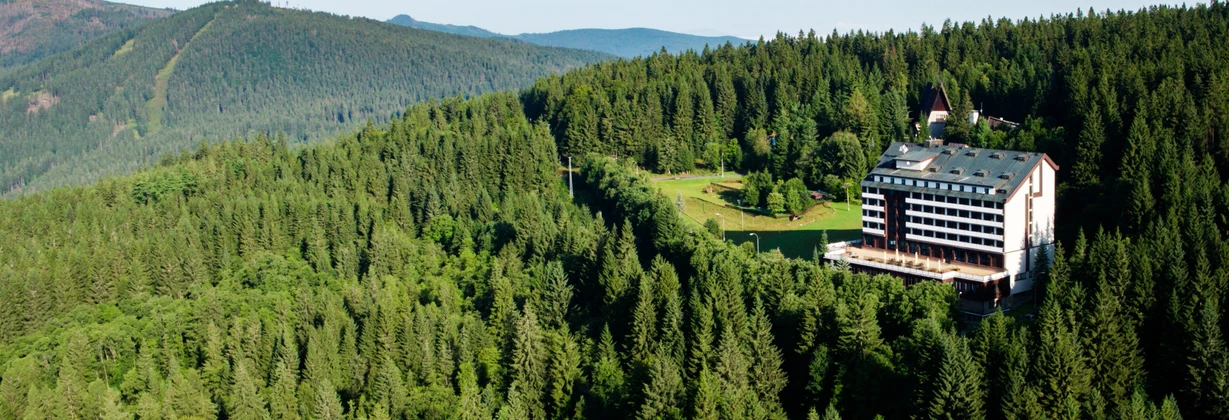The top of Pancíř Mountain (with an elevation of 1214 m) offers one of the most beautiful views of Šumava, on a clear day you can even see the Alps. It is accessible by a chair lift from the Špičák resort with the Hofman interchange station of a length of 2750 m. On the top is an observation tower with a restaurant. The distance from the hotel is 1.5 km.
Špičák
The most famous ski resort in Šumava (1202 m), with beautiful views of the surrounding area. Špičák is the main European watershed between the Black Sea and North Sea. Summer attractions for cyclists include the unique Bike Park. The cable car to the top is in operation during the summer months. The mountain has the longest railway tunnel in Bohemia (1748 m). The distance from the hotel is about 4 km.
Železná Ruda
This is the biggest sports and tourist centre in Šumava. The baroque church of Panny Marie Pomocné (the Virgin Mary) complete with dome is considered a local landmark. In the village there is a glass museum, a museum of historic motorcycles, and Šumava National Park Information Centre. The ‘Way of the Cross’ leading to the chapel near the Belvedere Hotel has been newly renovated. The distance from the hotel is 7 km on the Horizont Resort – Špičák – Železná Ruda route.
Enviromental center
Environmental center in Železná Ruda presenting nature and landscape protection in Sumava.
Velký Javor (Great Arber)
This is the highest mountain in Šumava, with an elevation of 1,455.5 metres (4,775 ft.), Although geographically belonging to Šumava (also known as the Bohemian Forest), it is often referred to as “King of the Bavarian Forest” as it crosses the Bavarian side of the border. Velký Javor (Great Arber) is forested, and the very top is composed of four rock formations. It is one of Germany’s most famous skiing resorts besides the Bavarian Alps. At the top is a wooden cross, two circular towers and a chapel of St. Bartholomew from the year 1956. At the top there’s also a cable car terminal and on the slopes of the mountain there’s a large number of ski lifts and ski runs. The distance from the hotel 15 km.
Klatovy
A famous Western Bohemian town, also known as the “Gate of Šumava” has 23,000 inhabitants. The city has a rich history and offers visitors a wealth of sights: catacombs dating back to the 17th century, the Black Tower, city walls, the town hall and the ‘U bílého jednorožce‘ pharmacy (By the White Unicorn), which is a UNESCO world heritage site due to its original Baroque features. The distance from the hotel is 40 km away.
Lakes in Šumava
All 8 glacial lakes (5 on the Czech and 3 on the Bavarian side) were formed by the gradual melting of the glaciers that had formed during the late Tertiary period – including the cooling of the climate in Central Europe – on (but not only) the mountainside slopes of Šumava. Melting glaciers pushed huge quantities of stone and gravel from which the slopes were formed to create a massive dam – moraine mounds. These dikes hold up the water – cut off from the glaciers during the last ice age. Of course the lakes currently supply the lower springs and tributaries.
Černé jezero (Black lake)
The Black Lake is located on the slopes of the Jezerní (Lakeside) mountains, 1343 m high. Black Lake is the largest lake in Šumava covering an area of 18.4 ha, and with a depth of 40.6 m (maximum depth of the lake is on the Czech side of Šumava) and lies at an altitude of 1008 m above sea level from its “twin” Čertovo jezero (Devil’s Lake) which is separated by a 330 m high wall formed by the Jezerní (Lakeside) mountains. It probably got its name due to apparently ‘black water’ created by the effect of the reflections from the surrounding dense forests. The bottom of the lake is covered with a several feet deep layer of pollen from the neighbouring conifer. The lake dam is reinforced and was the first pumped storage hydro power plant built in Czechoslovakia in the year 1929.
Čertovo jezero (Devil's lake)
Čertovo jezero (Devil’s Lake) is located at the southern slope of the Jezerní (Lakeside) mountains. Interestingly both lakes (Černé jezero and Čertovo jezero) have the same distance (direct distance of approximately 1.5 km) that runs along the ridge of the Jezerní (Lakeside) mountains as the main European watershed between the North Sea (Black Lake) and the Black Sea (Devil’s Lake). The lake is elevated at a height of 1030 m above sea level, its area is 10.3 hectares and maximum depth is 37 m. Another point of interest is that in 1911 the Black Lake and Devil’s Lake Reserve was established by the owner of the estate of the Prince of Hohenzollern on the initiative of the founder of modern conservation Hugo Connwentze. The area around the protected area of Black Lake and Devil’s Lake is 152 ha.
Prášilské jezero (Prášilské lake)
Prášilské Lake lies at an altitude of 1080 m above sea level; it was formed like the other Šumava lakes from subsidence from the Pleistocene glaciers. The lake is formed by a typical granite and gneiss kar that creates a 9 m high barrier and two older moraines mounds. Height of the kar wall above the lake is 150 m. The area of the lake is 3.7 hectares and the depth is up to 15 m. Under Prášilské Lake are the so-called old basin, swamp valley, and remains of the already overgrown lake.
Jezero Laka (Laka lake)
This is the highest and also the smallest lake in the Šumava having an area of 2.78 hectares and is located at an altitude of 1096 m below the mountain Plesná. This shallow lake is fed by two streams which has been gradually overgrown with vegetation and are now floating peat islands. In the 19th century the lake surface was increased by 2 artificial dikes from the original marsh with several lakes. The lake brook flows into Křemelná, and part of the water was drained through a narrow channel to glass making machines for the former Hůrka(‘Heights’).
Plešené jezero (Plešné lake)
Plešné lies at an altitude of 1090 m with clamped rocky shores in the middle of forest. Its area is 7.5 hectares, and in the past Schwarzenberg navigational canal was fed from this lake. The lake basin was formed by the Pleistocene glacier, and the left frontal moraine dam consists of a build-up of stone. The end of the dam reaches a height of 30-40 m and a width of 1 km makes it the widest lake in Šumava. There was a tourist lodge, from the times of early tourism (1911) which was later demolished.








